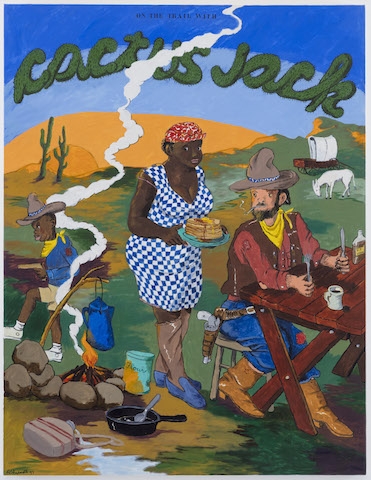Rich and flat and saturated as hell, all the colours in this decades-spanning exhibition by late painter Robert Colescott (1925–2009) cream and matt across history, from ancient pools through Old West skirmishes into more modern dalliances clipped from dirty magazines and canned ads. Colescott’s soft, bright pigments beam from lavender walls as a scantily clad lady gets peeped in her boudoir. They splash turquoise from Elysian swimming holes and harden into electric-blue skies where cottony white clouds are just as fluffy as the gunsmoke pouring from the pistols of assassins and banditos. His colours plump into the ripe skin and extreme curves of ladies in various states of undress, as well the ruddy lust of men on lascivious bosses, porno directors and smoking cowboys. In Midnight at the Mustang Ranch (1977), one such cowboy shuffles with his blue jeans wrapping his ankles, red long johns bursting as he wolfishly pursues a nudie sex worker.
Then there’s the colour of all Colescott’s characters’ skin: black, white and brown humans act out satires and tensions in assassinations and in battles, on movie sets and in racial dramas. The cartoonish features of the men and women possess a tricky tension, and you’re never sure in any given painting if he’s being satirical or sincere, political or mythological, erotic or sleazy, mockingly comic or terribly serious. In the same painting, there’s playful eroticism alongside a critique of racial stereotypes, a celebration of the bright, crass chroma of American pop culture that also takes it down for the ease of its exploitation. In the mock-advertisement painting Black Capitalism: Afro American Spaghetti (1971–73), it’s hard to tell whether he’s centralising an African-American family into a mainstream culture reference or chortling at capitalism’s cloying attempt to sell spaghetti to black folk (‘It is soul food… Two meat balls in every can’). It’s all of these things at once, of course. In an admixture of high and low, Colescott refuses easy cultural readings and facile politics. And when you clock all the fun he’s clearly having, it’s easy to see what makes his paintings and drawings so damned satisfying.
In the ‘Bathers’ series (1984–85), Colescott lingers in mythological moments through allusive titles and suggestive scenes. With a side glance at Cézanne and a jab at neoclassical whitewashing, Colescott paints his nudes with a darker palette. The bodies wetly frolicking here are primarily ancient black and brown goddesses with purple hair (with the very occasional shy, peachy-blond). As thick, sultry, and powerful as any of the women in Robert Crumb’s comics, Colescott’s cartoonish style of shaping bodies never entirely disappears even in these more classical, less jokey paintings. The expressive movements of his figures border on the mystical joy of William Blake but with a use of paint that remembers Philip Guston as both an abstract expressionist and a cartoony painter. Colescott took his references in a long career from the classical and commercial, the pop and pornographic, trawling history with a wet humour, but his colours and their bend are all his own.
Robert Colescott at Blum & Poe, Los Angeles, 10 March – 28 April
From the May 2018 issue of ArtReview
